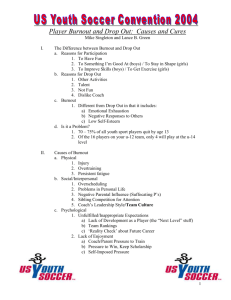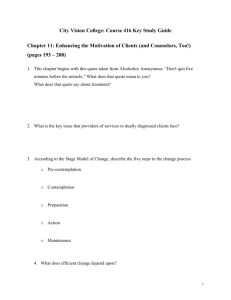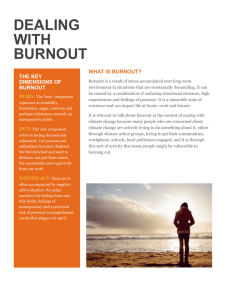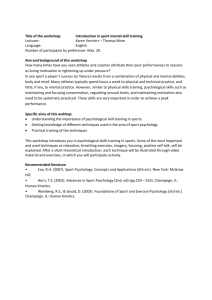Understanding Burnout in Sport - Sport Medicine and Science
advertisement
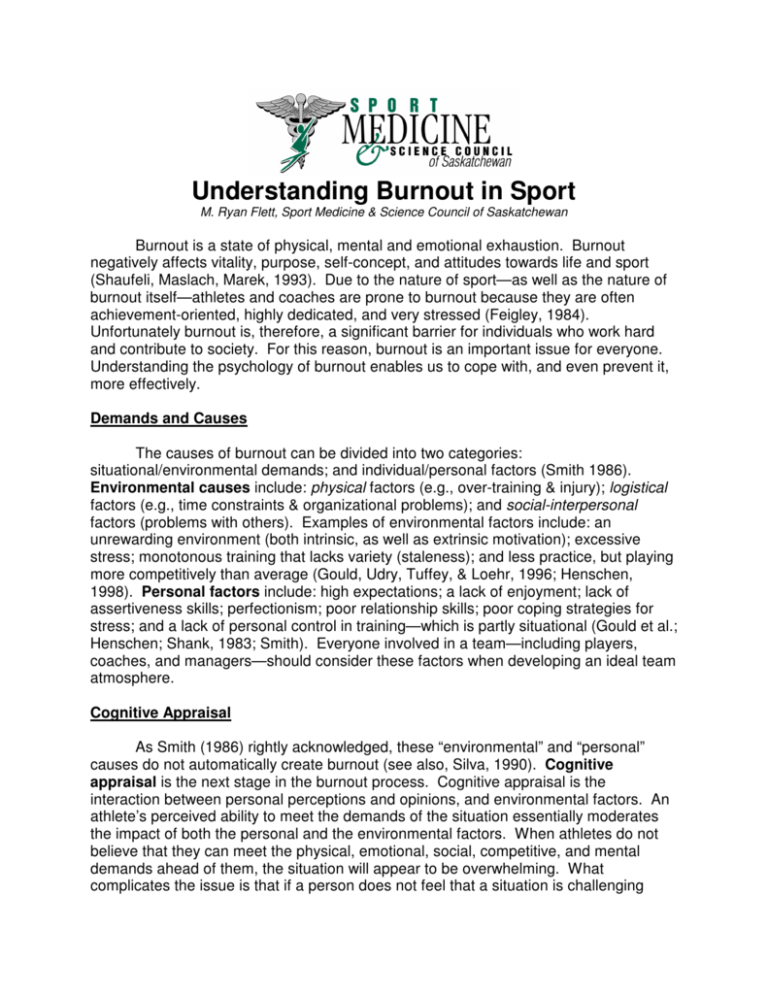
Understanding Burnout in Sport M. Ryan Flett, Sport Medicine & Science Council of Saskatchewan Burnout is a state of physical, mental and emotional exhaustion. Burnout negatively affects vitality, purpose, self-concept, and attitudes towards life and sport (Shaufeli, Maslach, Marek, 1993). Due to the nature of sport—as well as the nature of burnout itself—athletes and coaches are prone to burnout because they are often achievement-oriented, highly dedicated, and very stressed (Feigley, 1984). Unfortunately burnout is, therefore, a significant barrier for individuals who work hard and contribute to society. For this reason, burnout is an important issue for everyone. Understanding the psychology of burnout enables us to cope with, and even prevent it, more effectively. Demands and Causes The causes of burnout can be divided into two categories: situational/environmental demands; and individual/personal factors (Smith 1986). Environmental causes include: physical factors (e.g., over-training & injury); logistical factors (e.g., time constraints & organizational problems); and social-interpersonal factors (problems with others). Examples of environmental factors include: an unrewarding environment (both intrinsic, as well as extrinsic motivation); excessive stress; monotonous training that lacks variety (staleness); and less practice, but playing more competitively than average (Gould, Udry, Tuffey, & Loehr, 1996; Henschen, 1998). Personal factors include: high expectations; a lack of enjoyment; lack of assertiveness skills; perfectionism; poor relationship skills; poor coping strategies for stress; and a lack of personal control in training—which is partly situational (Gould et al.; Henschen; Shank, 1983; Smith). Everyone involved in a team—including players, coaches, and managers—should consider these factors when developing an ideal team atmosphere. Cognitive Appraisal As Smith (1986) rightly acknowledged, these “environmental” and “personal” causes do not automatically create burnout (see also, Silva, 1990). Cognitive appraisal is the next stage in the burnout process. Cognitive appraisal is the interaction between personal perceptions and opinions, and environmental factors. An athlete’s perceived ability to meet the demands of the situation essentially moderates the impact of both the personal and the environmental factors. When athletes do not believe that they can meet the physical, emotional, social, competitive, and mental demands ahead of them, the situation will appear to be overwhelming. What complicates the issue is that if a person does not feel that a situation is challenging enough, the result will be boredom and staleness. As such, it is critical that athletes perceive there to be a “skill-challenge balance” in their training (Jackson & Csikszentmihalyi, 1999). So how does the issue of “cognitive appraisal” affect our understanding of the burnout process? People must acknowledge that what they say may not be exactly what others hear. Perception is sometimes more important than reality, and the best way for people to understand what someone perceives is to establish open and trusting communication. In addition to understanding how an athlete perceives a situation, it can be helpful to assess their motives for participating (Raedeke et al., 2000). It is also important to remember that—because personalities are complicated, and situations offer copious demands—an athlete may have multiple cognitive appraisals of a situation. An athlete will often have several opinions. As such, a behavioural response is often a product of some type of cost-benefit analysis, rather than simple, linear thinking. Physiological Symptoms & Behavioural Responses “Behavioural Responses” represent the final stage of the cognitive-affective model (Smith, 1986). Behavioural responses are a product of cognitive appraisals and physiological responses, such as anxiety and fatigue. Behavioural responses to the antecedents of burnout include: changing moods, apathy, depersonalization, anxiety, emotional isolation, exhaustion, decreased motivation, low self-esteem, performance decrements, and even substance abuse (Henschen, 1998). For the most part, behavioural responses (or “symptoms”) are negative in that they have a detrimental effect on the well being, as well as the performance, of athletes. Although these symptoms of burnout are essentially natural coping strategies, it does not mean that they cannot, and should not, be changed. Tips for Prevention of Burnout (Dale & Weinberg, 1989; Gould et al., 1996; Henschen, 1998) Schedule breaks! During practices, and between competitions, give your athletes an opportunity to regroup, relax a little, and perhaps even smell the roses. Applying this idea to an entire season: it is important to provide athletes with a transition period where they can escape the sport environment. Allow your athletes a degree of decision-making autonomy. Anything that you can do to improve an individual’s perception of personal control, will improve that person’s confidence, productivity, and enjoyment. Teach athletes fundamental communication, stress management, and coping skills. Be weary of “going through the motions”…Variety—and even a degree of unpredictability in practice—can prevent staleness while making practice more challenging and thereby more productive. Challenge your athletes, but be realistic. Try to control outcomes whenever possible. This has a lot to do with the importance of perceiving control. Athletes who do not have a sense of control feel helpless, and perhaps even manipulated and hopeless. You could, for example, improve the probability of success in a particular drill. Minimize post-competitive tension. Teach athletes to deal with the results of competition (both good and bad) maturely. Lastly, be aware of burnout and staleness. Do what you can to create an environment that does not generate negative (i.e., counter-productive) attitudes. If you know someone that is in a bit of a slump, be aware of the fact that it could be burnout. In helping such individuals, be sensitive and compassionate; it is not entirely their fault that they are burning out! Assessing Burnout The following instruments have been recommended by Gould et al. (1996) and/or Henschen (1998). Eades Athletic Burnout Inventory (Eades, 1991). This is a 36-item inventory using a 7-point Likert scale. Before recently*, this was one of the only sport specific burnout inventories. COPE (Carver, Scheiere & Weintraub, 1989). This inventory uses a 4-point Likert scale across 52 items and is used to assess coping skills. Sport Anxiety Scale (Smith, Smoll, & Schutz, 1990). This is a 21-item inventory that uses a 4-point Likert scale. The Sport Motivation Scale (Pelletier, Tuson, Fortier, Vallerend, Brier, & Blais, 1995). This also uses a 7-point Likert scale. Multidemensional Perfectionism Scale (Frost, Marten, Lahart, & Rosenblate, 1990). This is a 35-item inventory using a 5-point Likert scale. Athletic Identity Measurement Scale (Brewer, Van Raalte, & Linder, 1993). This is a 10-item questionnaire with a 7-point Likert scale. Profile of Mood States (McNair, Lorr, & Droppleman, 1971). This assesses six different affect states, including: tension, depression, anger, confusion, fatigue and vigour. *Raedeke and Smith (2001) have recently devised a new assessment tool specifically for burn out in sport. References Brewer, B., Van Raalte, J., & Linder, D. (1993). Athletic Identity: Hercules’ muscles or Achilles’ heel? International Journal of Sport Psychology, 24, 237-254. Carver, C., Scheiere, M., & Weintraub, J. (1989). Assessing coping strategies: A theoretically based approach. Journal of Personality and Social Psychology, 56 (2), 237-254. Dale, J., & Weinberg, R.S., (1989). The relationship between coaches’ leadership style and burnout. The Sport Psychologist, 3, 1-13. Eades, A. (1991). An investigation of burnout in intercollegiate athletes: The development of the Eades Athletic Burnout Inventory. Paper presented at the North American Society for the Psychology of Sport & Physical Activity National Conference, Asilomar, CA. Feigley, D.S. (1984). Psychological burnout in high-level athletes. The physician and Sports Medicine, 12 (10), 109-112, 115-119. Frost, R., Marten, P., Lahart, C., & Rosenblate, R. (1990). The dimensions of Perfectionism. Cognitive Therapy and Research, 14, 449-468. Gould, D., Udry, E., Tuffey, S., & Loehr, J. (1996). Burnout in competitive junior tennis players: I. A quantitative psychological assessment. The Sport Psychologist, 10, 322-340. Henschen, K.P. (1998). Athletic Staleness and Burnout: Diagnosis, prevention, and treatment. In J.M. Williams (Ed.), Applied Sport Psychology: Personal Growth to Peak Performance (3rd ed., pp. 398-408). Mountain View, CA: Mayfield Publishing Company. Jackson, S.A., & Csikszentmihalyi, M. (1999). Flow in Sports. Champaign, IL: Human Kinetics. McNair, D.M., Lorr, M., & Droppleman, L.F. (1971). EDITS manual for the Profile of Mood States. San Diego, CA: Editorial and Industrial Testing Service. Pelletier, L., Tuson, K., Fortier, M., Vallerend, R., Brier, N., & Blais, M. (1995). Toward a new measure of intrinsic motivation, extrinsic motivation, and amotivation in sports: The Sport Motivation Scale (SMS). Journal of Sport and Exercise Psychology, 17 (1), 35-53. Raedeke, T.D., & Smith, A.L. (2001). Development and preliminary validation of an athlete burnout measure. Journal of Sport and Exercise Psychology, 23 (4), 281306. Shaufeli, W.B., Maslach, C., & Marek, T. (1993). Professional burnout: Recent developments in theory and research. Washington DC: Taylor & Francis. Shank, P.A., (1983). Anatomy of burnout. Parks and Recreation, 17, 52-58. Silva, J.M., (1990). An analysis of training stress syndrome in competitive athletics. Journal of Applied Sport Psychology, 2, 5-20. Smith, R. (1986). Toward a cognitive-affective model of athletic burnout. Journal of Sport Psychology, 8, 36-50. Smith, R., Smoll, F., & Schutz, R. (1990). Measurements and correlates of sportspecific cognitive and somatic trait anxiety: The Sport Anxiety Scale. Anxiety Research, 2, 263-280.
